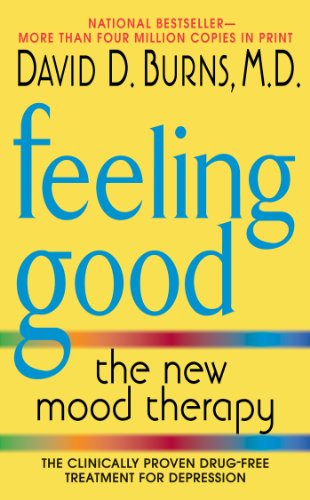
Depression may not be something we’d like to openly and seriously talk about. It can even take a certain amount of courage and vulnerability to acknowledge this feeling within us, but life can be tough, and depression sometimes does occur when we’re facing challenges and difficulties in our job, our family, our school, our relationships that feel insurmountable. How can we maintain a positive, upbeat attitude without letting hardship knocks us into depression? How can we maintain a healthy mind, so that we can be resilient no matter what life throws at us?
I recently finished the book Feeling Good written by Dr. David D. Burns. Reading it has been hugely beneficial because it has equipped me with the knowledge and tools to identify and combat depression. I highly recommend it and believe that you can benefit from it too, even if you’re not depressed.
Thoughts → Feelings & Behaviors
Dr. Burns is an expert in Cognitive Behavioral Therapy, also known as CBT. I’d come across this term quite a few times before, and this book gave me a deep dive into its underlying theory.
CBT is premised on this idea that our feelings and behaviors stem from our cognition, which is our mental activities and thoughts. Depression, in fact, is caused by our distorted thoughts. By changing our thoughts, our way of thinking, we can reverse depression.
At first, I was a bit unsure if changing the way we think could really lead to that much of a change in our feeling, but after practicing some of the tools introduced by the book, I was able to feel less heavy when something upsetting happened. The challenges and difficulties were still there, but I became more observant of my negative thoughts: I learned to catch them, talk back to them and challenge them when they popped into my head. My mood seemed to get better, and I could deal with the situation from a more grounded position, with a more positive mindset.
The 10 Cognitive Distortions
Cognitive distortions are the negative, inaccurate thought patterns that lead to our depression. The book mentions 10 of them, which include all-or-nothing thinking, overgeneralization, mental filter, disqualifying the positive, jumping to conclusions, mind reading, fortune teller error, magnification and minimization, emotional reasoning, should statements, labeling and mislabeling, and personalization.
Life consists of a lot of grays, and yet many of us fall into the trap of seeing the world through the black and white lens without being aware of it. Perhaps that’s an easy mental shortcut to take so we don’t need to spend time and energy analyzing and understanding what’s actually going on. However, engaging in this kind of all-or-nothing thinking in the long run can cause a lot of harm, including depression.
I feel that we probably unconsciously pick up or develop these cognitive distortions from other people, the society or the environment we are in. Racism, to me, is a type of overgeneralization and all-or-nothing thinking: the judgement of one member or a few members of the group, is overgeneralized to every member of that group. When some people act or behave in a racist manner, others who are not educated on the harm of it could potentially mirror the behavior and develop the same type of racist thinking. Learning these cognitive distortions helps me think about issues like these from a new perspective and become more immune to endorsing or mimicking these behaviors caused by the skewed thinking of other people.
Perfectionism is another type of all-or-nothing thinking. We place unrealistic demands on ourselves and others and require that we or others be flawless and not make any mistakes in our job, in our relationship, at school… Dr. Burns reminds us and his patients in the book that we are not omnipotent: we are human beings, not god.
By acknowledging that we are all imperfect, we have more capacity to forgive and let go, and be more compassionate and kind to ourselves and others. Instead of focusing on the bad, the imperfect, we look for what’s been going right and be grateful for it, and find the silver linings we tend to overlook in a tough circumstance.
The Double-Column Technique and Role Play
The book introduces a number of tools to help us expose our own distorted thoughts or long-held values that are not serving us, and replace them with more rational ones, one of which is the double-column technique, and it works like this.
Whenever we feel upset, write down our thoughts, not feelings, in the first column. Then in the second column, identify which of the 10 cognitive distortions are lurking behind those thoughts and write down a more rational version to establish a more balanced view.
Cognitive distortions are like knots in our head. When we challenge them and replace them with rational thinking, it’s as if those knots are finally disentangled.
Besides the double-column technique, another useful tool to combat cognitive distortions is role play. The book is full of inspiring stories or interesting conversations between Dr. Burns and his patients where they swapped their roles or play the role of a third person to create empathy and help the patients see their own distorted thinking. It was engaging to read through.
Final Thoughts
Our self-esteem is closely related to depression. Some base it on achievement, whether that’s in academia, career or finance. Others base it on skill, ability or appearance.
Judging our worth based on external factors that we have no control over is an unreliable way to build self-esteem and a recipe for depression. We might be good at solving math problems, but we can’t guarantee that we’ll be able to solve every math problem in every test. We might be smart, but there will always, always, be someone that’s smarter than us in some way or another.
For so long, I had valued myself on being the kid that got the best grade in class or the student who passed exams with flying colors, which made me fragile. Now, after reading this book, I finally realized that the right thing to build my self-esteem on, is my inner qualities.
Here’s what I wrote down on my journal.
I don’t pride myself on being the best. I pride myself on:
- Believing in a friendly universe.
- Not getting lost in all-or-nothing thinking: I’m not nothing, and others are not god.
- Accepting the fact that a lot of things are not so black and white.
- Not jumping to conclusion or engaging in mind reading.
- Not seeing failures or setbacks as the end of the world but rather a golden opportunity to learn and grow.
- Being at peace with the imperfections in life.
- Being willing to try things and improve from where I’m even when the situation is not ideal.
- Being able to focus on a just cause even when faced with fierce competition.
- Being willing to let go and forgive.
- Being able to push through and work hard.
This is the vision I have for myself. I’m not there yet: there’s still a lot I need to work on, but I know it’s the right path to go, the right way to build my identity.

